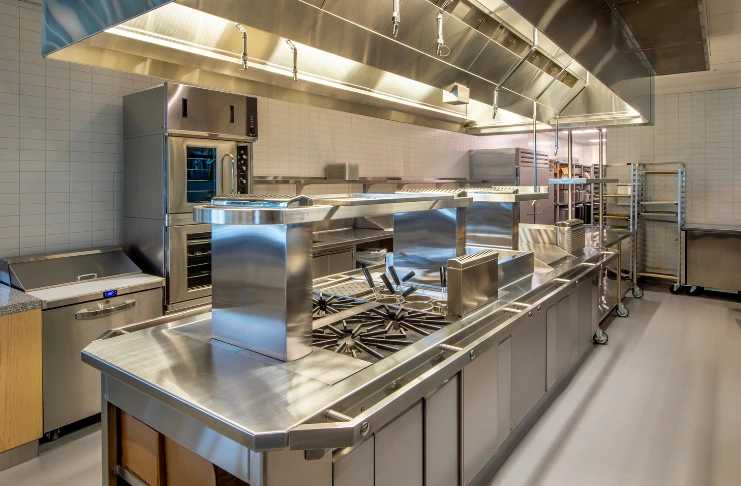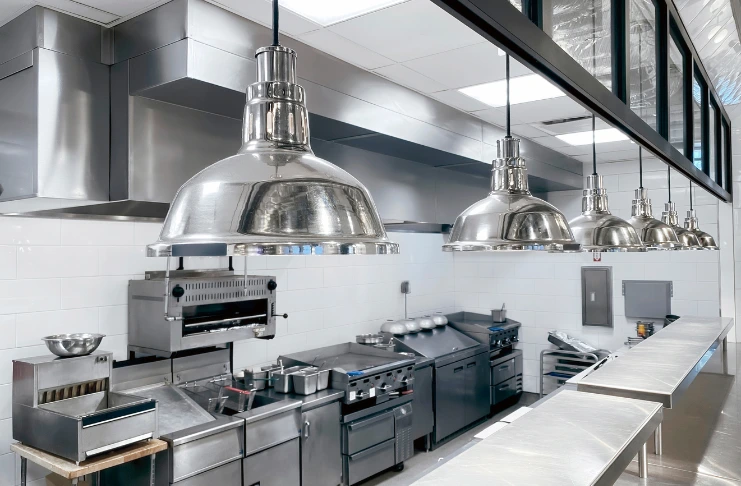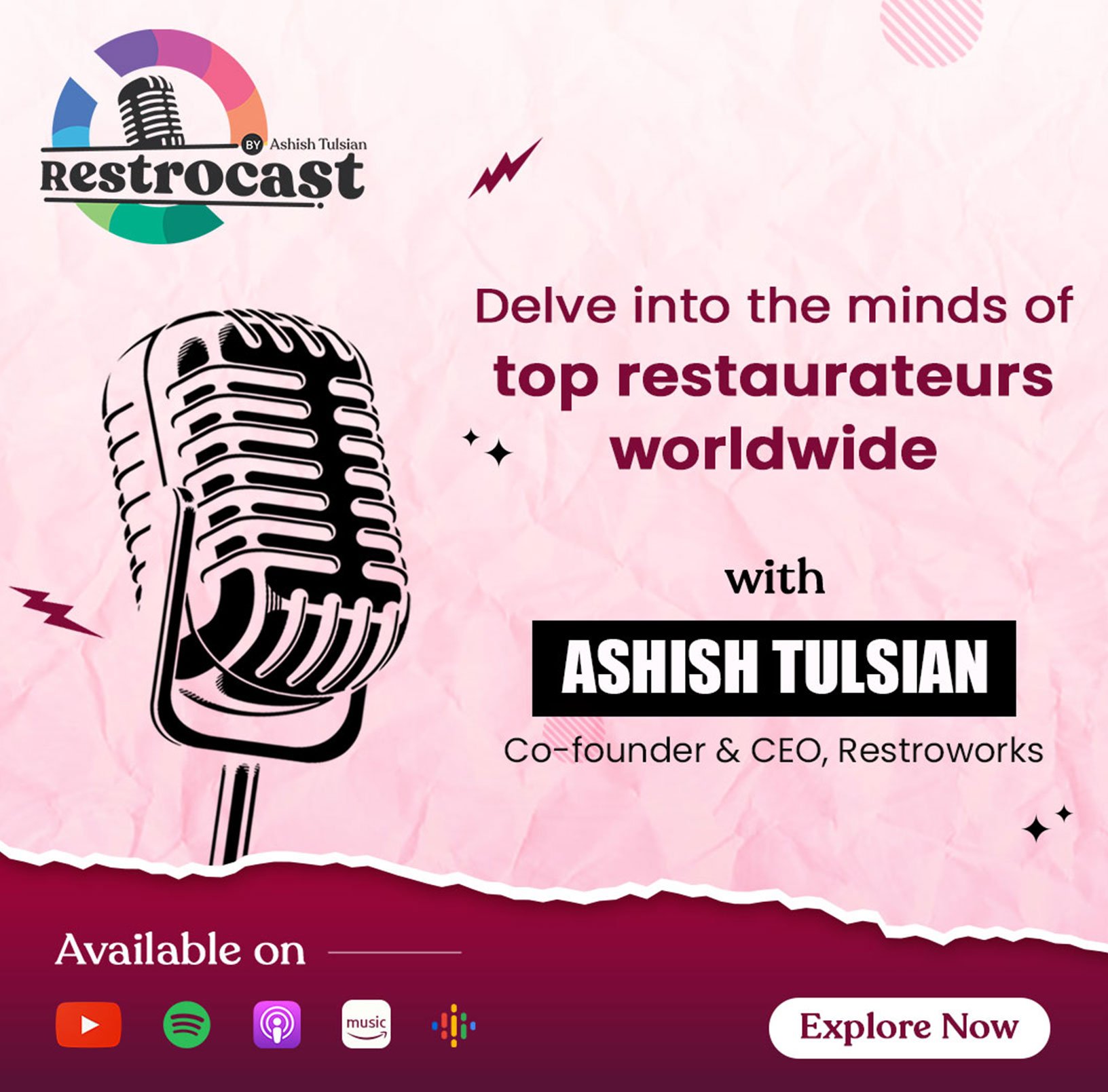
The restaurant industry is undergoing a significant transformation in today’s fast-paced digital world. One of the most innovative trends reshaping the food service sector is the rise of ghost kitchens—delivery-only restaurants that operate without traditional dine-in spaces.
Ghost kitchens are also known as virtual kitchens, cloud kitchens, and dark kitchens are delivery-only restaurants that operate without a traditional storefront. Instead of serving customers in-house, they focus entirely on fulfilling online food orders through apps like Uber Eats, DoorDash, and Grubhub. Ghost kitchens are quickly becoming a go-to model for restaurant owners looking to boost profits with minimal risk.
Why are ghost kitchens booming? Lower startup costs, greater flexibility, and the ability to reach more customers without the constraints of a physical location make this model incredibly appealing. Whether you’re a first-time food entrepreneur or an established restaurant looking to expand, a ghost kitchen allows you to test new menus, optimize operations, and scale efficiently—all while maximizing revenue.
In this blog, we’ll dive deep into everything you need to know about starting a ghost kitchen—from understanding the business model and setting up operations to marketing strategies and best practices for success. If you’ve ever dreamed of running a restaurant that thrives in the digital era, this guide will show you how to turn that vision into reality.
What Is A Ghost Kitchen?
A ghost kitchen, also known as a virtual, dark, or cloud kitchen, is a delivery-only restaurant that operates without a dine-in space or customer-facing storefront. The global ghost kitchen market is projected to grow from an estimated $71.14 billion in 2023 to approximately $157.26 billion by 2030, reflecting a compound annual growth rate (CAGR) of 12% over the forecast period.
Also known as dark kitchens, ghost kitchens operate solely for producing delivery orders without a physical restaurant or storefront. By eliminating the front-of-house aspect, restaurants can expand and experiment with new concepts while minimizing investment risks.
How Ghost Kitchens Differ From Traditional Restaurants And Cloud Kitchens

Unlike traditional restaurants, which serve customers in a physical location, ghost kitchens operate exclusively for delivery—no dining room, waitstaff, or expensive real estate required. While cloud kitchens are a broader category that includes all types of delivery-focused food businesses, ghost kitchens specifically function without a brick-and-mortar presence.
How To Open A Ghost Kitchen
Opening a ghost kitchen can be profitable, as it allows you to operate a restaurant without the costs associated with a traditional dine-in establishment. Here are the essential steps to launch a successful ghost kitchen:
Step 1: Conduct Market Research For Your Ghost Kitchen
Thorough market research is necessary before launching a ghost kitchen. Unlike traditional restaurants, ghost kitchens rely entirely on delivery and takeout services, so analyzing the demand in your target area is essential.
1.1 Assess The Popularity Of Food Delivery In Your Location
Start by evaluating the demand for food delivery in your city or neighborhood. Urban areas and densely populated suburbs often have higher delivery order volumes, while rural regions may not support a ghost kitchen due to low demand. Use tools like Google Trends, Census Data, and food delivery app reports to identify areas with strong online food ordering habits.
1.2 Analyze Competition From Existing Ghost Kitchens
Investigate local competitors operating in the ghost kitchen space. Look at their menu offerings, pricing, customer reviews, and delivery times. This helps identify market gaps and opportunities to differentiate your brand. If multiple ghost kitchens serve the same cuisine, consider a unique concept or niche menu to stand out.
1.3 Understand Consumer Preferences & Best-Selling Cuisines
Identify high-demand cuisines by researching best-selling dishes on Uber Eats, DoorDash, and Grubhub. Look at seasonal trends, dietary preferences (vegan, gluten-free, keto), and customer behavior to design a menu that attracts frequent orders.
1.4 Build Strategic Partnerships With Delivery Platforms
Since third-party apps dominate the online ordering, partnering with food delivery services like Uber Eats, Grubhub, and DoorDash is essential. Check commission fees, delivery coverage, and promotional opportunities to optimize your visibility and profitability on these platforms.
Step 2: Choose The Right Ghost Kitchen Business Model
Selecting the right ghost kitchen business model is crucial in determining your operational efficiency, costs, and scalability. Different models cater to various budgets and business goals, so understanding each type will help you make an informed decision.
2.1 Independent Ghost Kitchen
An independent ghost kitchen is a self-owned and operated facility where you rent a commercial kitchen space and manage everything yourself, including licensing, food preparation, and delivery logistics. This model offers complete control over branding, menu pricing, and profit margins, but it also comes with higher upfront costs, including rent, utilities, and kitchen equipment.
2.2 Shared/Commissary Kitchen
A shared or commissary kitchen is a cost-effective option where multiple food businesses operate from a fully-equipped, licensed kitchen. You pay for space on a subscription or hourly basis, reducing overhead expenses. This model is ideal for startups and small food businesses looking for a flexible, low-investment entry into the ghost kitchen market.
2.3 Restaurant Conversion
Many brick-and-mortar restaurants turn to the virtual kitchen model by utilizing their existing kitchen space to operate a secondary delivery-only brand. This allows restaurant owners to maximize their kitchen’s capacity and generate additional revenue without increasing fixed costs.
2.4 Third-Party Ghost Kitchen Facility
Companies like CloudKitchens, Kitchen United, and Reef Kitchens provide ready-to-use ghost kitchen spaces with built-in services, including delivery platform integrations, maintenance, and logistical support. These facilities streamline operations and reduce initial setup costs, making them a good option for entrepreneurs looking for a turnkey solution.
Step 3: Register Your Business & Obtain Permits For A Ghost Kitchen

Since ghost kitchens operate as food service businesses, they must comply with local, state, and federal regulations to ensure food safety and legal operation. Proper business registration and permits are essential to avoid fines, delays, or shutdowns. Here’s how to complete this step efficiently.
3.1 Register Your Business
The first step in legally operating a ghost kitchen is registering your business entity. Choose a structure that aligns with your goals:
- LLC (Limited Liability Company): Offers legal protection and flexibility.
- Corporation (S-Corp or C-Corp): Best for larger operations and investors.
- Sole Proprietorship: Suitable for single-owner businesses but lacks liability protection.
Register your business with the Secretary of State’s office in your state and obtain a Doing Business As (DBA) if you plan to use a unique brand name.
3.2 Obtain An Employer Identification Number (EIN)
An EIN (Employer Identification Number) is required for tax filing, hiring employees, and setting up a business bank account. You can apply for an EIN online through the IRS.
3.3 Apply For A Food Service License
A food service license is mandatory to operate legally. You must apply through your state or local health department, and your kitchen must meet food safety and hygiene regulations before approval.
3.4 Secure A Health Inspection Permit
Before launching your ghost kitchen, your facility must pass a health inspection to ensure compliance with FDA food safety standards and state health codes. The local health department will conduct routine inspections to verify compliance.
3.5 Get A Business License & Check Zoning Laws
Obtain a business license from your city or county government. Additionally, check zoning regulations to confirm that your chosen kitchen location can legally operate as a food business.
3.6 Acquire Business Insurance
Protect your ghost kitchen by securing essential business insurance, including:
- General Liability Insurance: Covers accidents and damages.
- Workers’ Compensation Insurance: Required if you have employees.
- Product Liability Insurance: Protects against food-related claims.
Step 4: Secure A Commercial Kitchen Space For Your Ghost Kitchen
Choosing the right commercial kitchen space is essential for ensuring smooth operations, efficiency, and compliance with health regulations. Your kitchen setup will depend on your ghost kitchen business model, budget, and operational needs. Below are the most common options for securing a kitchen space.
4.1 Leasing A Commercial Kitchen Space
Renting a dedicated commercial kitchen gives you complete control over your operations. This option is ideal if you want to customize the kitchen layout, install specialized equipment, and operate independently. However, it requires a higher upfront investment in rent, utilities, and kitchen setup.
4.2 Partnering With A Commissary Or Shared Kitchen
A commissary kitchen is a shared commercial kitchen space where multiple food businesses operate. These kitchens come fully equipped with essential appliances, allowing you to reduce startup costs. Many also offer flexible rental plans, making them an excellent choice for startups and small-scale ghost kitchens.
4.3 Renting From Third-Party Ghost Kitchen Providers
Companies like CloudKitchens, Kitchen United, and REEF Kitchens provide turnkey ghost kitchen facilities with built-in services like order fulfillment, technology integration, and delivery support. This option simplifies setup and streamlines operations.
4.4 Using An Existing Restaurant Kitchen
Some restaurant owners lease their kitchen space to ghost kitchen operators during off-peak hours. This is a cost-effective solution that allows you to test your concept before committing to a full-scale operation.
Step 5: Design Your Ghost Kitchen Menu For Maximum Profitability And Efficiency

Designing a high-performing menu is crucial for the success of a ghost kitchen. Since these kitchens operate without a dine-in experience, the menu must be optimized for delivery, profitability, and customer satisfaction. A well-structured menu can increase order volume, reduce food costs, and enhance the overall dining experience for customers.
5.1 Optimize For Delivery
Unlike traditional restaurant menus, ghost kitchen menus must feature dishes that travel well and maintain their taste, texture, and appearance during transit. Avoid items that become soggy, lose freshness quickly, or require complicated plating. Popular delivery-friendly foods include burgers, sandwiches, grain bowls, and fried items that retain crispiness. Before launching, testing your menu items in different packaging and delivery conditions is essential.
5.2 Focus On Profitability & Scalability
A successful ghost kitchen menu should be cost-effective and scalable. Minimize the number of ingredients to streamline kitchen operations and reduce food waste. Consider using cross-utilization strategies, where ingredients are used across multiple dishes to lower inventory costs while maintaining variety. Pricing should be competitive yet profitable, factoring in food costs, packaging, and delivery fees.
5.3 Invest In Efficient & Sustainable Packaging
Since presentation matters even in delivery, use high-quality, eco-friendly packaging that keeps food fresh and intact. Opt for compostable containers, insulated packaging for hot meals, and spill-proof designs to enhance the customer experience. Branding your packaging with stickers, QR codes, or thank-you notes can also improve customer retention and engagement.
Step 6: Set Up A POS & Online Ordering System For Your Ghost Kitchen

A seamless online ordering and POS system is essential for managing orders efficiently in a ghost kitchen. Since ghost kitchens rely solely on delivery and takeout, investing in the right technology ensures smooth operations, faster order processing, and a better customer experience.
6.1 Enable Direct Ordering On Your Website
While third-party delivery apps are popular, they charge high commission fees that can cut into your profits. Setting up direct online ordering on your website allows customers to order without extra charges. Use an integrated online ordering system that supports secure payments, real-time order tracking, and customer data collection to build long-term relationships.
6.2 Partner With Third-Party Delivery Apps
Register with leading food delivery apps like Uber Eats, Grubhub, and DoorDash to maximize reach. These platforms drive traffic and visibility to your ghost kitchen. However, to minimize reliance, consider running promotions on your website to encourage direct orders and retain customers.
6.3 Integrate A Smart POS System
A point-of-sale (POS) system that integrates with multiple ordering platforms ensures centralized order management. This eliminates manual entry errors and improves efficiency. Choose a cloud-based POS which syncs with third-party delivery services, kitchen printers, and analytics dashboards.
Step 7: Optimize Delivery & Logistics for Your Ghost Kitchen
Efficient delivery and logistics are the backbone of a successful ghost kitchen. Since your business relies entirely on takeout and food delivery, optimizing the process ensures faster order fulfillment, better customer satisfaction, and increased repeat business.
7.1 Choose Between Self-Delivery Or Third-Party Services
You can either manage deliveries in-house or partner with third-party delivery services like Uber Eats, DoorDash, and Grubhub. Each option has its pros and cons:
- Self-delivery: This provides full control over the customer experience, allows for branding opportunities, and avoids high commission fees from third-party apps. However, it requires investment in delivery drivers, vehicle maintenance, and route planning software.
- Third-Party Delivery Services: Offer instant access to a large customer base, eliminate the need to hire drivers, and handle logistics. However, commission fees can reduce profit margins, so it’s best to mix both methods when possible.
7.2 Improve Kitchen Workflows For Faster Order Processing
An optimized kitchen layout and workflow reduces preparation times and ensures quick order fulfillment. Implement strategies like:
- Dedicated prep stations to streamline cooking.
- Automated kitchen display systems (KDS) for real-time order tracking.
- Efficient packaging stations for faster dispatching.
7.3 Use Order Tracking Systems For Real-Time Updates
Customers expect real-time tracking of their orders. Use POS-integrated tracking systems or third-party delivery app features to keep customers informed. Providing accurate ETA updates and notifications enhances the customer experience and builds trust.
Step 8: Develop A Strong Brand & Marketing Strategy For Your Ghost Kitchen

Since ghost kitchens operate without a storefront, they rely heavily on digital marketing to attract customers and drive orders. A strong brand presence and marketing strategy can help increase visibility, establish credibility, and generate repeat business.
8.1 Create A Mobile-Friendly Website With Online Ordering
A professional website is the foundation of your ghost kitchen’s brand. It should be mobile-optimized, as most customers place orders via smartphones. Key features include:
- Easy online ordering with secure payment options.
- Clear menu presentation with appetizing images and descriptions.
- Customer reviews and testimonials to build trust.
- Contact information and delivery areas for easy access.
8.2 Leverage Social Media For Promotions & Engagement
Platforms like Instagram, TikTok, and Facebook are powerful tools for promoting your ghost kitchen. Post high-quality food photos, behind-the-scenes videos, and customer testimonials to drive engagement. Running paid ads, influencer collaborations, and hashtag campaigns can expand your reach and attract new customers.
Industry Insight
The food industry has undergone a significant shift with the rise of cloud kitchens, reshaping traditional dining by prioritizing convenience, efficiency, and a seamless digital experience. A report in Financial Express explores how social media plays a key role in expanding ghost kitchens:
“Social media platforms are crucial in influencing consumer preferences and purchase decisions in the current digital era. Cloud kitchen operators may successfully promote their offerings, interact with clients, and increase brand awareness by leveraging social media.
89% of consumers use social media to communicate with brands, according to a Sprout Social poll, underscoring the importance of having a strong social media presence. Cloud kitchens may capture their audience and cultivate a sense of community by producing engaging content, such as delectable culinary photographs, behind-the-scenes peeks, and interactive surveys”.
8.3 Optimize For SEO & Google My Business
Optimizing your website for SEO (Search Engine Optimization) will improve your local discoverability. Use keywords related to your cuisine and location, such as “best burger delivery in NYC” or “vegan ghost kitchen in Los Angeles.” Additionally, claim and optimize your Google My Business listing to appear in local search results and Google Maps.
8.4 Offer Promotions & Loyalty Programs
Offer discounts on first orders, referral incentives, and loyalty rewards to encourage first-time customers to try your food. Free delivery days can boost conversions and increase customer retention.
Step 9: Ensure Compliance With Health & Safety Standards

Maintaining strict health and safety standards is essential for running a successful ghost kitchen. Since ghost kitchens operate without in-person customer interactions, food safety and hygiene are crucial in ensuring customer trust and regulatory compliance.
9.1 Implement Food Safety Protocols
Following established food safety guidelines, such as HACCP (Hazard Analysis and Critical Control Points) and ServSafe certification, helps prevent contamination and foodborne illnesses. These protocols focus on safe food storage, temperature control, and proper handling of ingredients to maintain food quality and safety.
9.2 Train Employees On Proper Food Handling & Hygiene
Proper training ensures that employees follow strict hygiene practices, such as:
- Washing hands regularly to prevent contamination.
- Wearing gloves, masks, and hairnets while preparing food.
- Separating raw and cooked foods to avoid cross-contamination.
- Following temperature guidelines for food storage and cooking.
Regular staff training sessions and refresher courses keep employees updated on best practices for food safety.
9.3 Maintain Cleanliness & Pass Health Inspections
To comply with local health department regulations, your kitchen must always be clean and well-maintained. This includes:
- Sanitizing surfaces and kitchen equipment daily.
- Storing ingredients properly to prevent spoilage.
- Scheduling routine pest control and waste disposal.
Step 10: Launch & Scale Your Ghost Kitchen
Successfully launching and scaling your ghost kitchen requires a strategic approach to testing operations, analyzing performance, and expanding your brand. A well-executed launch helps refine your processes, attract customers, and position your business for long-term success.
10.1 Start With A Soft Launch & Gather Feedback
Before a full-scale launch, conduct a soft launch to test your kitchen’s workflow, online ordering system, and delivery efficiency. Offer a limited menu and take orders through select platforms to identify operational gaps. Encourage early customers to provide feedback on food quality, packaging, and delivery speed to make necessary improvements before expanding.
10.2 Analyze Performance Metrics
Tracking key performance indicators (KPIs) helps measure your ghost kitchen’s success:
- Order volume and frequency to identify peak hours.
- Delivery times to ensure fast service.
- Customer reviews and ratings on delivery platforms.
- Food cost and profit margins to optimize pricing.
Use analytics tools and POS data to make data-driven decisions and improve efficiency.
10.3 Expand & Scale Your Brand
Once operations are stable, consider expanding your ghost kitchen by:
- Adding new virtual brands under the same kitchen.
- Partnering with influencers and local food bloggers for marketing.
- Expanding to additional delivery platforms to increase reach.
Advantages And Scope Of The Ghost Kitchen Business Model
Cloud kitchens are increasingly emerging as alternatives for those who prefer to order home-cooked food from outside. Here are some advantages of a ghost kitchen business model when compared to a standalone restaurant.
1. Lower Infrastructure Cost
One of the biggest advantages of the ghost kitchen model is its low infrastructure cost. Without the need for a dine-in space, expensive decor, or large real estate investments, expenses are primarily focused on setting up and maintaining the kitchen area.
2. Scalability
Since the cloud kitchen market is booming, it seems like the right time to invest in a cloud kitchen. Since the startup cost for opening a ghost kitchen is one-third of that of a traditional restaurant, it is easier to scale the operations.
3. Low Overhead Cost
It takes money to keep a restaurant open every single day. It could be your electricity costs or your rent; there are many overhead costs involved in the functioning of a restaurant. Since the business model of a ghost kitchen doesn’t demand any of that, the overhead costs are much lower than setting up a physical restaurant.
4. One-Time Investment
Another key benefit of a ghost kitchen is that it requires a one-time investment. The major financial commitment happens during the initial kitchen setup, without the ongoing costs of renovations or frequent interior updates. Once established, a cloud kitchen can generate revenue over the long term with minimal additional expenses.
5. Capturing A Wider Audience
Traditional restaurants are restricted by space and seating capacity, limiting the number of guests they can serve at a time. In contrast, cloud kitchens are not bound by these physical constraints, allowing them to handle unlimited orders based on demand and operational capacity.
Conclusion
Starting a ghost kitchen is a great way to enter the food industry with lower costs and a focus on delivery. With the rise of online food ordering, there’s never been a better time to launch your own delivery-only restaurant. By following the right steps—researching your market, securing a kitchen space, setting up an efficient ordering system, and marketing your brand—you can build a profitable business. If you’re ready to get started, begin by choosing a business model, obtaining the necessary permits, and creating a menu that travels well. Use social media and online promotions to attract customers and grow your brand. The key to success is efficiency, quality, and great customer service. Take the first step today and turn your food business idea into reality!
Frequently Asked Questions
The cost to start a ghost kitchen varies widely, ranging from $10,000 to $50,000 for a small setup in a shared kitchen to $100,000+ for a fully equipped independent space. Costs depend on location, kitchen equipment, technology, and marketing expenses.
To start a ghost kitchen, you need a commercial kitchen space, cooking equipment, ingredients, packaging materials, an online ordering system, and partnerships with delivery platforms. Additionally, you’ll need business licenses, food safety permits, and marketing strategies to attract customers.
Yes, ghost kitchens are legal in the USA, but they must comply with local health and safety regulations, business licensing, and zoning laws. Regulations vary by state and city, so it’s essential to check with local authorities before starting.
Ghost kitchens make money by selling food exclusively through online orders and delivery apps, reducing overhead costs compared to traditional restaurants. Profitability increases with efficient menu pricing, strong branding, digital marketing, and optimizing delivery operations.
Yes, ghost kitchens can be highly profitable due to low operational costs, no front-of-house expenses, and the ability to run multiple virtual brands from one kitchen. However, success depends on demand, marketing, and efficient cost management.
The failure rate of ghost kitchens is more within the first few years, often due to high competition, poor marketing, unreliable food quality, and unsustainable delivery costs. Success requires strong branding, streamlined operations, and high customer retention.
Yes, you can start a ghost kitchen at home, but it depends on local food laws and regulations. Some areas allow home-based food businesses under cottage food laws, while others require a commercial kitchen license.
Running a dark kitchen from home is possible if local laws permit home-based food businesses. You may need to obtain health department approvals, business licenses, and follow strict food safety regulations.
To start a ghost kitchen at home, check local food regulations, obtain necessary licenses, set up a compliant kitchen, create an online ordering system, and market your brand. Partnering with delivery platforms or offering direct ordering can help scale your business.
Yes, ghost kitchens can be profitable if they manage costs effectively, optimize menu pricing, and build a strong online presence. Success often depends on repeat customers, strategic marketing, and delivery efficiency.








